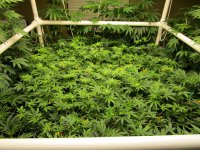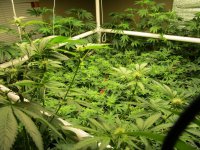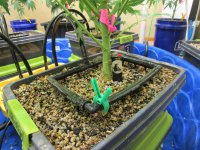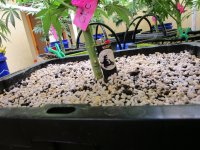all seedlings are showing pre-flowers which is a relief since they are supposed to be fems.
readings in the hand-watered plants' reservoir containers are running about 870 ppm and 6.2. i take these from the drain overflow hole in the sidewall with a large turkey syringe. this is with the same input as the recirculating system. 5.7-5.8 and 840 ppm.
all plants look great and have shown no signs of transplant stress or shock. they continued growing as if nothing had happened.
no signs of deficiencies. no spotting or interveinal chlorosis.
turned on the dehuey as the room is up to about 65% at times. i don't want it any higher than that.
today 2-22-22, i set timers for flowering. first long dark period starting at 2:30 pm.
it's interesting to note that the four plants in the system, 2 orange kush cakes and 2 planet of the grapes, have stems that are at least 30% larger in diameter than the ones outside the system being hand watered. same strains, same age, same nutrients, same treatment except one set is in the ppk system.
i am going to try a new flower schedule for me. i know a lot of you experienced growers using high-intensity lighting have seen what i and others call "hitting the wall".
this is only noticed by folks running light at max levels. 1500 to 2000 umols.
cannabis plant metabolism ramps up linearly with increasing light until you reach about 1500 umols. there it plateaus until 2000 umols. after 2000 umols is exceeded metabolism drops off radically as in straight down on the graph.
this almost never happens in nature because we just don't get light much more intense than that.
but what we do see is plants using various light avoidance strategies after they have absorbed more light than the plant can process.
cannabis twists leaf ends and droops leaves in an attempt to attenuate light.
you don't see this with weak lighting but you folks that have run sunlight supply de's at 1500 umols have. i have recently seen the plant avoiding light in late afternoon in july in the field.
the wall occurs about 8 hrs into the light period.
i think i have seen it in timelapse videos.
also, with all the new led lighting we have seen another phenomenon. an unexplained slight nutrient problem related to perhaps the photosynthetic apparatus being driven more efficiently with leds than with hid lighting because the IR radiation of the hid lights is suppressing metabolism.
the led lights are causing an increase in the need for magnesium.
under hps lights i never needed to add mag using tap water. now i do.
all chlorophyll molecule types have a central magnesium atom.
since going to the modified 3-2-1 jacks, the slight interveinal chlorosis and calcium spotting have stopped.
back to the light schedule.
we mostly use a 12-12 flowering schedule. i recently read about sunflowers avoiding light late in the day. then other papers showed that various plants have light avoidance strategies.
i'm sure most of you are familiar with the term "daily light integral". this is the sum total of light a plant receives in a diurnal period. all plants evolved under a diurnal cycle.
we know that the highest light readings on the planet are in the 72 mole range.
taking nashville tn as an example, the highest total sunlight per day received here is in the 45 moles range. this is about 35 degrees latitude in late july or early aug.
research has shown cannabis can be grown with as little as 25 moles per day but for good production 35--45 moles is better.
most cannabis gurus tell you to run 800-1200 umols for the 12 hour period. but they don't explain why.
few people are actually measuring light and the led manufacturers know this. so they advise you to run the whole 12 hours so you get enough yield to think they have a good light.
and, most of the time the lights are so weak that you better follow their advice.
so taking the math for 1000 umols of light flow x 3600 sec in an hour x 12 hours we get 43.2 moles per diurnal period.
same math for 1500 umols x 3600 x 8 hours and we still get 43.2 moles per period.
being a short day facultative plant we know it won't stop flowering with 8 on and 16 off.
it will get the exact same amount of light in the diurnal period but without what?
it will reduce the prolonged exposure to heat. it will reduce electrical cost for lighting by 1/3. and electrical cost for cooling by the same ratio.
i'm hoping the reduction in heat and radiation exposure in general will help in terpene preservation.
we know terps have lower evaporative points than cannabinoids.
well, enough bs for now.
readings in the hand-watered plants' reservoir containers are running about 870 ppm and 6.2. i take these from the drain overflow hole in the sidewall with a large turkey syringe. this is with the same input as the recirculating system. 5.7-5.8 and 840 ppm.
all plants look great and have shown no signs of transplant stress or shock. they continued growing as if nothing had happened.
no signs of deficiencies. no spotting or interveinal chlorosis.
turned on the dehuey as the room is up to about 65% at times. i don't want it any higher than that.
today 2-22-22, i set timers for flowering. first long dark period starting at 2:30 pm.
it's interesting to note that the four plants in the system, 2 orange kush cakes and 2 planet of the grapes, have stems that are at least 30% larger in diameter than the ones outside the system being hand watered. same strains, same age, same nutrients, same treatment except one set is in the ppk system.
i am going to try a new flower schedule for me. i know a lot of you experienced growers using high-intensity lighting have seen what i and others call "hitting the wall".
this is only noticed by folks running light at max levels. 1500 to 2000 umols.
cannabis plant metabolism ramps up linearly with increasing light until you reach about 1500 umols. there it plateaus until 2000 umols. after 2000 umols is exceeded metabolism drops off radically as in straight down on the graph.
this almost never happens in nature because we just don't get light much more intense than that.
but what we do see is plants using various light avoidance strategies after they have absorbed more light than the plant can process.
cannabis twists leaf ends and droops leaves in an attempt to attenuate light.
you don't see this with weak lighting but you folks that have run sunlight supply de's at 1500 umols have. i have recently seen the plant avoiding light in late afternoon in july in the field.
the wall occurs about 8 hrs into the light period.
i think i have seen it in timelapse videos.
also, with all the new led lighting we have seen another phenomenon. an unexplained slight nutrient problem related to perhaps the photosynthetic apparatus being driven more efficiently with leds than with hid lighting because the IR radiation of the hid lights is suppressing metabolism.
the led lights are causing an increase in the need for magnesium.
under hps lights i never needed to add mag using tap water. now i do.
all chlorophyll molecule types have a central magnesium atom.
since going to the modified 3-2-1 jacks, the slight interveinal chlorosis and calcium spotting have stopped.
back to the light schedule.
we mostly use a 12-12 flowering schedule. i recently read about sunflowers avoiding light late in the day. then other papers showed that various plants have light avoidance strategies.
i'm sure most of you are familiar with the term "daily light integral". this is the sum total of light a plant receives in a diurnal period. all plants evolved under a diurnal cycle.
we know that the highest light readings on the planet are in the 72 mole range.
taking nashville tn as an example, the highest total sunlight per day received here is in the 45 moles range. this is about 35 degrees latitude in late july or early aug.
research has shown cannabis can be grown with as little as 25 moles per day but for good production 35--45 moles is better.
most cannabis gurus tell you to run 800-1200 umols for the 12 hour period. but they don't explain why.
few people are actually measuring light and the led manufacturers know this. so they advise you to run the whole 12 hours so you get enough yield to think they have a good light.
and, most of the time the lights are so weak that you better follow their advice.
so taking the math for 1000 umols of light flow x 3600 sec in an hour x 12 hours we get 43.2 moles per diurnal period.
same math for 1500 umols x 3600 x 8 hours and we still get 43.2 moles per period.
being a short day facultative plant we know it won't stop flowering with 8 on and 16 off.
it will get the exact same amount of light in the diurnal period but without what?
it will reduce the prolonged exposure to heat. it will reduce electrical cost for lighting by 1/3. and electrical cost for cooling by the same ratio.
i'm hoping the reduction in heat and radiation exposure in general will help in terpene preservation.
we know terps have lower evaporative points than cannabinoids.
well, enough bs for now.





